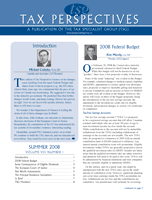
PDF Format
 Issue Contents Issue Contents
 All Issues All Issues
Summer 2008
Volume 8, Number 1
The information in Tax Perspectives is prepared for general interest only. Every effort has been made to ensure that the contents are accurate. However, professional advice should always be obtained before acting and TSG member firms cannot assume any liability for persons who act on the basis of information contained herein without professional advice.
Net Worth Assessments
By Grace Chow, CA, TEP
Cadesky and Associates LLP (Toronto)
Out of the blue, with no advance warning, you receive a letter from the CRA requesting that you provide your personal banking records. This is followed by further requests for other personal information, such as credit card statements, and details of personal living expenses. Then, in a meeting, you are asked a number of questions, such as do you gamble, have you taken on any personal debts recently, and did you receive any large gifts from relatives or friends?
You realize at this point that something is unusual, and terribly wrong. However, you are not quite sure what it is. With your accountant at your side, you tackle these questions, and the CRA goes away. Many months go by and you hear nothing, until you receive a letter containing a number of schedules and spreadsheets. The letter states that the CRA has determined that you have unreported income totalling $600,000 over the past three years, that your corporation is going to be reassessed for this income, and so are you. In addition, a 50% penalty will be applied. The tax and penalties amount to 120% of the income, and interest will apply on top of this. You are now snared in a net worth assessment.
The CRA has been increasingly using net worth assessments to detect unreported income. But why did they pick on you?
The CRA uses a risk assessment model to determine whether a net worth assessment analysis is warranted. Typical targets are persons who operate cash businesses (construction is a favourite, along with retail stores and restaurants), who report low income or losses, have poor accounting records, and have an apparently increasing net worth. Sometimes the CRA gets leads from unidentified sources (such as an upset employee, or an estranged spouse). Sometimes they pick up the idea from preparing to audit the company, and identify something that appears unusual.
Regardless of how and why the CRA picked you as a candidate for a net worth assessment, once you are involved, there is no turning back.
How does a net worth assessment audit work?
The Income Tax Act allows the CRA to issue an assessment on an arbitrary basis, or by using various audit methods. The net worth assessment fits within this, and has been held to be valid. Defences such as a violation of charter rights have not found merit with the Courts.
The CRA does an analytical review of a person's net worth and then calculates the net worth at a point in time (January 1, 2003 for example). They then calculate the net worth three years later, say December 31, 2005. The difference is the increase in net worth. To this, reasonable living expenses are added, because these have to be funded in some way. Then the person's income during the three years in question is considered, to see whether it explains the increase in net worth and the estimated expenses over the period. If so, that is the end of the matter. If not, and no additional information is forthcoming, the difference is considered unreported income. The CRA then looks at the most likely source of unreported income (generally from a cash business of some sort, either carried on personally or in corporate form). The unexplained difference is considered by the CRA to be income of this business, triggering the assessments described above.
The CRA frequently has incomplete information, which makes net worth assessments inaccurate. Also, the CRA's assumptions can often be unrealistic. In one particular case, the CRA included cash withdrawals from ATM machines as living expenses. The amounts were used to buy groceries, which were separately listed under living expenses. Clearly there was a double count.
The CRA may also leave out important information. For example, if a person's assets increased significantly because they put a mortgage on their house, there is no increase in net worth. If the mortgage is not entered as a liability, the calculations can be materially wrong.
A net worth assessment is fought by finding errors with CRA's calculations. Often this comes from supplying additional information. Sometimes CRA will negotiate a settlement to finish the matter. Penalties can be waived by CRA on occasion.
Despite the inaccuracies of the net worth assessment audit approach, the CRA can be very tenacious in requesting the taxpayer to disprove the assessments. Even if the discrepancies are quite small (say $20,000 in a particular year), the CRA has been known to press forward with reassessments.
If you, or anyone you know, are unlucky enough to be asked about personal banking records, personal expenses, or other questions not directly related to income taxes, be wary. It could be the start of a net worth assessment. If you have done nothing wrong, you have nothing to fear. Still, get professional advice immediately.
|